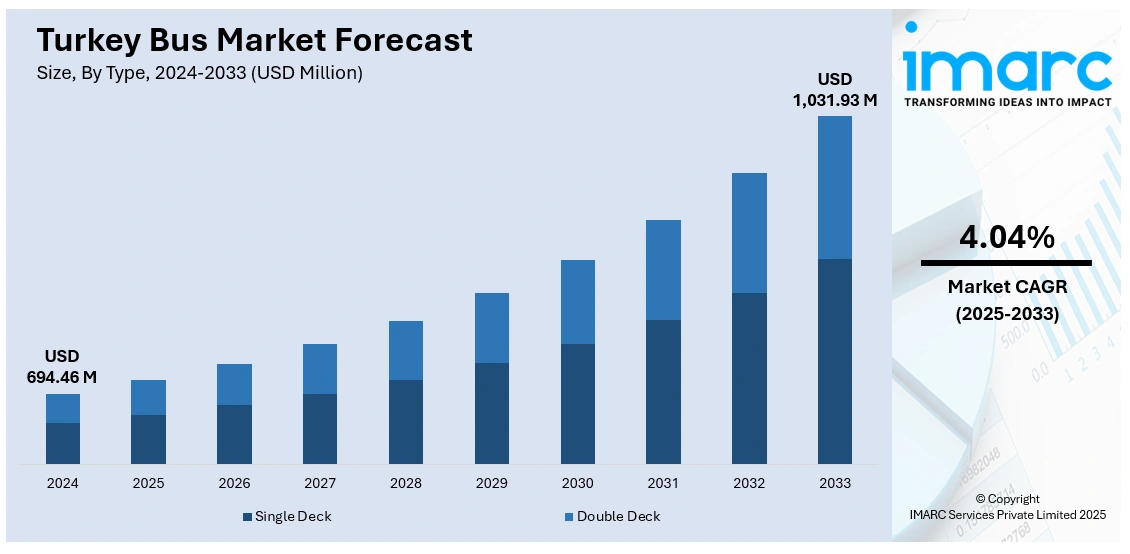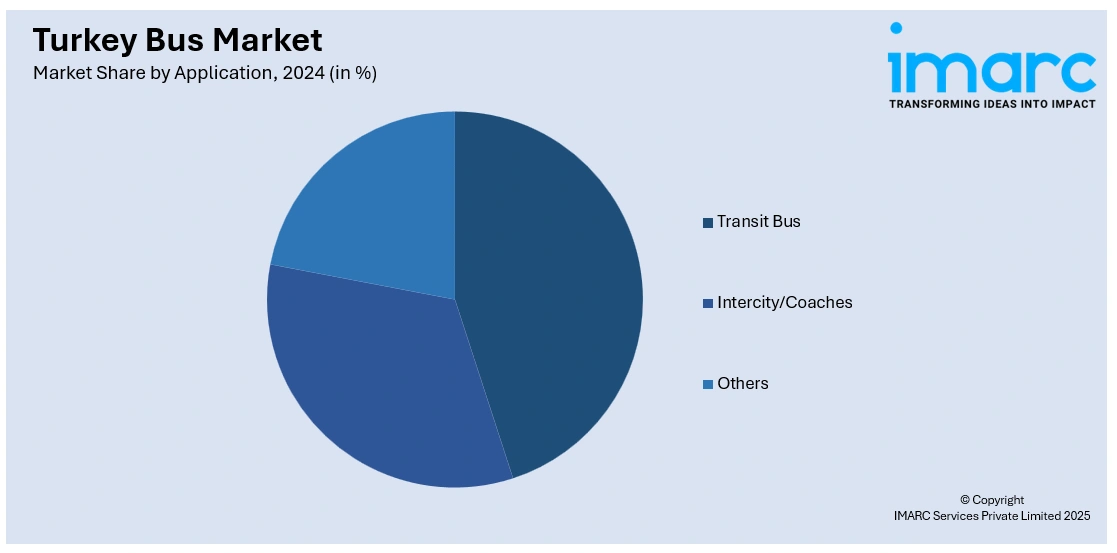
Turkey Bus Market Size, Share, Trends and Forecast by Type, Fuel Type, Seat Capacity, Application, and Region, 2025-2033
Turkey Bus Market Overview:
The Turkey bus market size reached USD 694.46 Million in 2024. The market is projected to reach USD 1,031.93 Million by 2033, exhibiting a growth rate (CAGR) of 4.04% during 2025-2033. The market is fueled by rising demand for green urban mobility, intercity mobility growth, and government-supported infrastructure improvements. Modern bus fleets are being increasingly adopted as cities focus on emission reduction and passenger comfort. Growing tourism also plays a role in increased intercity and coach travel demands. Investments in smart transport systems and electrification also influence the trend. Collectively, these drive the competitiveness and operational effectiveness of the industry, making overall Turkey bus market share stronger.
|
Report Attribute
|
Key Statistics
|
|---|---|
|
Base Year
|
2024
|
|
Forecast Years
|
2025-2033
|
|
Historical Years
|
2019-2024
|
| Market Size in 2024 | USD 694.46 Million |
| Market Forecast in 2033 | USD 1,031.93 Million |
| Market Growth Rate 2025-2033 | 4.04% |
Turkey Bus Market Trends:
Increasing Use of Electric and Hybrid Buses
The Turkey bus market is increasingly adopting global sustainability through the use of electric and hybrid buses. Urban areas especially are promoting a switch to cleaner transport to decrease air pollution and improve energy efficiency. Local investments in charging technology are fueling this shift, making it possible for fleets to be backed by stable energy sources. This trend not only offers greater environmental advantage but also saves money in the long run. Transit authorities are paving the way, slowly phasing out diesel buses with cleaner options. As riders' expectations change, advanced energy solutions-backed modern fleets are the preferred means of city transportation. This shift illustrates how the market growth is being driven by environmental concerns and emerging technologies, pointing towards a greater revolution in mobility. The Turkey bus market trends increasingly reflect sustainability as a defining feature for the future of passenger transport.

To get more information on this market, Request Sample
Increased Demand for Intercity and Long-Distance Travel
Intercity and long-distance travel are now a vital force behind the Turkey bus industry, spurred by tourism, student travel, and business commuting between urban centers. In December 2024, Bursa-based Turkish manufacturer Karsan announced plans to enter Turkey’s intercity electric bus market in 2025 with its 12-metre low-floor e-ATA Class II model, designed for short-distance intercity travel and urban transport. Furthermore, buses have continued to be an affordable option compared to flying or using rails, providing inter-regional connectivity that other modes of transport cannot. Growing domestic tourism has boosted demand for luxury buses with comfort amenities like reclining chairs, onboard internet, and higher safety technologies. Furthermore, the affordability and accessibility of buses make them suitable for a broad population, guaranteeing steady demand. Upgrades to infrastructure, such as highway widening and terminal improvements, are also optimizing efficiency and travel convenience. These conditions favor further development in intercity transportation. The growth of Turkey’s bus market is supported by these developments, reflecting how evolving travel trends are shaping the industry. The market trends persist in emphasizing intercity buses as an anchor of the passenger mobility structure in the country.
Consolidation of Intelligent and Networked Bus Technologies
Digitalization is exercising a significant impact on the Turkey bus market, with networked technologies becoming the epicenter of contemporary fleets. Telematics, real-time GPS, passenger information, and digital ticketing-enabled smart buses are transforming efficiency and customer experience. These innovations not only improve route optimization and scheduling but also enhance security through advanced monitoring systems. Connected services for passengers also offer greater convenience, transparency, and comfort, which lead to a better travel experience. The shift towards digital integration is also complemented by smart city initiatives, where data-led solutions are being utilized to control urban mobility. Since both private and public operators adopt these innovations, the growth in the Turkey bus market is fueled by better service and optimized operations. Digital connectivity in the market trends indicates that digital interconnectivity will be a determining factor in shaping transportation infrastructure across the country.
Turkey Bus Market Segmentation:
IMARC Group provides an analysis of the key trends in each segment of the market, along with forecasts at the country and regional levels for 2025-2033. Our report has categorized the market based on type, fuel type, seat capacity, and application.
Type Insights:
- Single Deck
- Double Deck
The report has provided a detailed breakup and analysis of the market based on the type. This includes single deck and double deck.
Fuel Type Insights:
- Diesel
- Electric and Hybrid
- Others
A detailed breakup and analysis of the market based on the fuel type have also been provided in the report. This includes diesel, electric and hybrid, and others
Seat Capacity Insights:
- 15-30 Seats
- 31-50 Seats
- More than 50 Seats
The report has provided a detailed breakup and analysis of the market based on the seat capacity. This includes 15-30 seats, 31-50 seats, and more than 50 seats.
Application Insights:

- Transit Bus
- Intercity/Coaches
- Others
The report has provided a detailed breakup and analysis of the market based on the application. This includes transit bus, intercity/coaches, and others.
Regional Insights:
- Marmara
- Central Anatolia
- Mediterranean
- Aegean
- Southeastern Anatolia
- Black Sea
- Eastern Anatolia
The report has also provided a comprehensive analysis of all the major regional markets, which include Marmara, Central Anatolia, Mediterranean, Aegean, Southeastern Anatolia, Black Sea, and Eastern Anatolia.
Competitive Landscape:
The market research report has also provided a comprehensive analysis of the competitive landscape. Competitive analysis such as market structure, key player positioning, top winning strategies, competitive dashboard, and company evaluation quadrant has been covered in the report. Also, detailed profiles of all major companies have been provided.
Turkey Bus Market News:
- In June 2024, Bozankaya unveiled its New Generation Bus series at Busworld Turkey 2024, comprising 10, 12, 18, and 25-meter electric buses. Fully in-house designed and developed, the series succeeds the Sileo range, providing low-floor, noiseless travel and a 360 kW charging system intended to upgrade Turkey's green urban transport network.
- In May 2024, Anadolu Isuzu launched the 'Novo Volt' electric midi coach, a 7.3-metre bus with seating for 29 passengers. Its 320 kW electric drivetrain, 165 kWh battery, and 225 km range were highlighted, along with the company's announcement of developments on an upcoming new fuel cell bus.
Turkey Bus Market Report Coverage:
| Report Features | Details |
|---|---|
| Base Year of the Analysis | 2024 |
| Historical Period | 2019-2024 |
| Forecast Period | 2025-2033 |
| Units | Million USD |
| Scope of the Report |
Exploration of Historical Trends and Market Outlook, Industry Catalysts and Challenges, Segment-Wise Historical and Future Market Assessment:
|
| Types Covered | Single Deck, Double Deck |
| Fuel Types Covered | Diesel, Electric and Hybrid, Others |
| Seat Capacities Covered | 15-30 Seats, 31-50 Seats, More than 50 Seats |
| Applications Covered | Transit Bus, Intercity/Coaches, Other |
| Regions Covered | Marmara, Central Anatolia, Mediterranean, Aegean, Southeastern Anatolia, Black Sea, Eastern Anatolia |
| Customization Scope | 10% Free Customization |
| Post-Sale Analyst Support | 10-12 Weeks |
| Delivery Format | PDF and Excel through Email (We can also provide the editable version of the report in PPT/Word format on special request) |
Key Questions Answered in This Report:
- How has the Turkey bus market performed so far and how will it perform in the coming years?
- What is the breakup of the Turkey bus market on the basis of type?
- What is the breakup of the Turkey bus market on the basis of fuel type?
- What is the breakup of the Turkey bus market on the basis of seat capacity?
- What is the breakup of the Turkey bus market on the basis of application?
- What is the breakup of the Turkey bus market on the basis of region?
- What are the various stages in the value chain of the Turkey bus market?
- What are the key driving factors and challenges in the Turkey bus market?
- What is the structure of the Turkey bus market and who are the key players?
- What is the degree of competition in the Turkey bus market?
Key Benefits for Stakeholders:
- IMARC’s industry report offers a comprehensive quantitative analysis of various market segments, historical and current market trends, market forecasts, and dynamics of the Turkey bus market from 2019-2033.
- The research report provides the latest information on the market drivers, challenges, and opportunities in the Turkey bus market.
- Porter's five forces analysis assist stakeholders in assessing the impact of new entrants, competitive rivalry, supplier power, buyer power, and the threat of substitution. It helps stakeholders to analyze the level of competition within the Turkey bus industry and its attractiveness.
- Competitive landscape allows stakeholders to understand their competitive environment and provides an insight into the current positions of key players in the market.
Need more help?
- Speak to our experienced analysts for insights on the current market scenarios.
- Include additional segments and countries to customize the report as per your requirement.
- Gain an unparalleled competitive advantage in your domain by understanding how to utilize the report and positively impacting your operations and revenue.
- For further assistance, please connect with our analysts.
 Request Customization
Request Customization
 Speak to an Analyst
Speak to an Analyst
 Request Brochure
Request Brochure
 Inquire Before Buying
Inquire Before Buying




.webp)




.webp)












